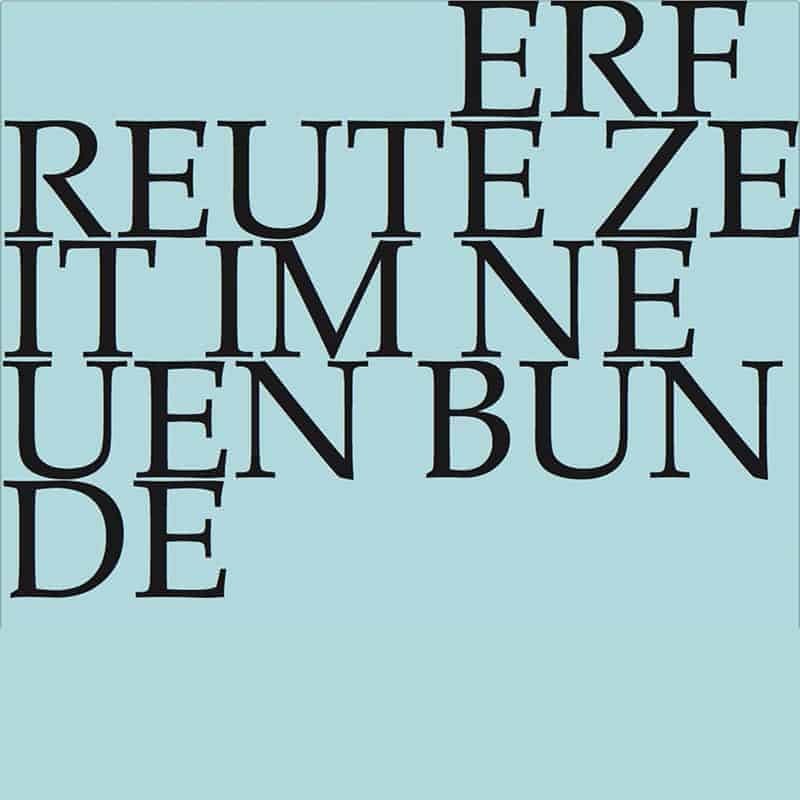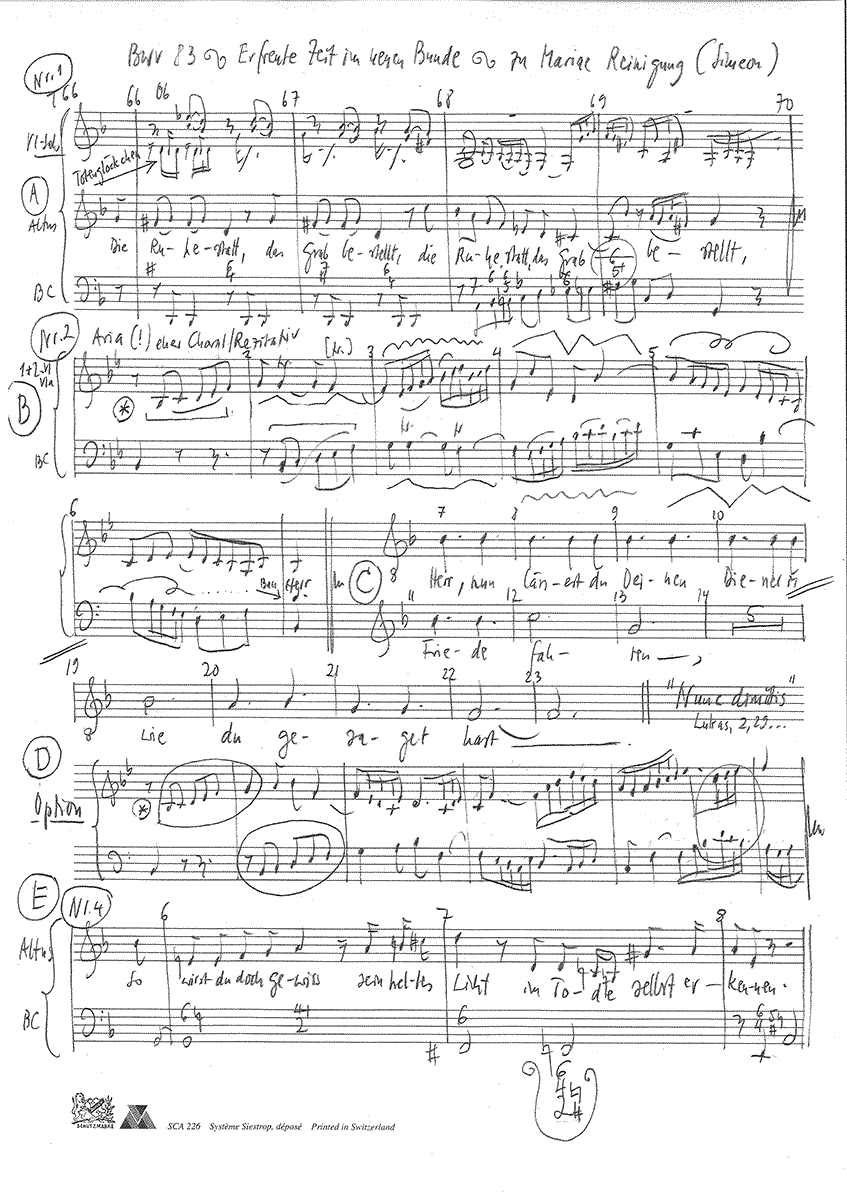Erfreute Zeit im neuen Bunde
BWV 083 // For the Purification of the Blessed Virgin Mary
(O joyous day of the new order) for alto, tenor and bass, vocal ensemble corno I+II, oboe I+II, violino concertato, strings and basso continuo

Would you like to enjoy our videos ad-free? Subscribe to YouTube Premium now...
Workshop
Reflective lecture
Choir
Soprano
Jan Börner
Orchestra
Conductor
Rudolf Lutz
Violin
Renate Steinmann, Monika Baer, Yuko Ishikawa, Elisabeth Kohler, Ildikó Sajgó, Eva Saladin, Anita Zeller
Viola
Susanna Hefti, Matthias Jäggi, Martina Zimmermann
Violoncello
Martin Zeller, Bettina Messerschmidt
Violone
Iris Finkbeiner
Oboe
Katharina Arfken, Dominik Melicharek
Bassoon
Susann Landert
Corno
Olivier Picon, Thomas Müller
Organ
Nicola Cumer
Harpsichord
Dirk Börner
Musical director & conductor
Rudolf Lutz
Workshop
Participants
Karl Graf, Rudolf Lutz
Reflective lecture
Speaker
Cornelia Kazis
Recording & editing
Recording date
20/02/2015
Recording location
Trogen
Sound engineer
Stefan Ritzenthaler
Director
Meinrad Keel
Production manager
Johannes Widmer
Production
GALLUS MEDIA AG, Switzerland
Producer
J.S. Bach Foundation of St. Gallen, Switzerland
Librettist
Text No. 1, 3, 4
Poet unknown
Text No. 2
Poet unknown and Luke 2:29–31
Text No. 5
Martin Luther, 1524 (from Luke 2:32)
First performance
The Purification of the Blessed Virgin Mary,
2 February 1724
In-depth analysis
Composed for the Purification of the Blessed Virgin Mary (2 February) in 1724, cantata BWV 83 is set to a libretto that draws strongly on the story of Simeon, who, in a vision, learned he would not die until he had seen the Messiah. The ancient prophet thus serves as a role model of devout preparation for the hereafter, and the Canticle of Simeon from the Gospel of Luke (“Lord, now lettest thou thy servant depart in peace”) is a recurrent theme in almost all movements of this work.
The cantata’s overarching theme of humility is reflected in the small size of the vocal ensemble, although the introductory aria forms a remarkable exception. With two additional horns and a solo violin – similar scoring to Bach’s Brandenburg Concerto No. 1 – the movement opens in brilliant concerto style and thus transforms the promise made to Simeon into a song celebrating the entire Christian community, which was brought into being through the birth of the Messiah: “O joyous day of the new order, When our belief doth Jesus hold”. Throughout this setting, the concertante violin, rapidly scaling several registers, evokes the divine morning star in much the same way as cantata BWV 1 – a fitting mood for a composition that still basks in the joy of the Epiphany. The contrasting middle section then illuminates the text of “that resting place, the grave” in introverted, pianissimo tones ere the da capo section recapitulates the brilliant, courtly music that proclaims the Christ child as the true King of Heaven.
Although the following bass aria adheres closely to the Gospel text, this movement, too, defies all listener expectations: framed by a structure of continuo and unison strings whose symbolic, ascending figure is set as a strict canon at an octave, the vocal line eschews all soloistic devices and commences with a quasi-Gregorian chant, thus emphasising the Song of Simeon as a particularly venerable legacy. Integrated into this hermetic structure is, surprisingly, a recitative that interprets the message of the ancient canticle for the listeners of Bach’s time; arioso phrases and fragments of the canon repeatedly interrupt the vocalist ere the second part of the Bible dictum (“For mine own eyes now have indeed thy Saviour regarded”) resumes the archaic style of the opening section. In this setting, Bach applied considerable rigour and discipline in order to express his respect for the biblical song.
The following movement, a further aria set for tenor, solo violin and strings, is devoted entirely to moral contemplation. Set in the style of a rapid bourrée, the solo violin dances over the cheerful orchestral accompaniment with feather-light triplets – a perfect backdrop for the tenor’s joyous calls of “Eilet!” (hasten). In this heroic solo, the emphasis is not on Simeon’s wish to die, but rather on the powerful acts of faith inspired by a believer’s certainty of receiving grace.
The alto recitative then lends expression to elements of worry and sorrow that, until now, had only been hinted at in this consoling music. Here, the darkness of the grave as well as the doubt stirred by the remoteness of God are allowed to gain the upper hand, ere the “radiant light” renders even the last hours of death bearable.
“He is salvation’s blessed light” – in drawing upon ancient texts, Bach and his librettist honour tradition and close the cantata with the fourth verse of Luther’s hymn based on the Canticle of Simeon. Rather than being effusively jubilant, the final words of praise – “He’s thy people’s Israel; the praise, fame, joy, and glory” – have a sombre and binding character and thus crown a cantata that is, even by Bach’s standards, remarkable for uniting such disparate styles as modern concerto and suites with the time-old customs of early church music.
Libretto
1. Arie (Alt)
Erfreute Zeit im neuen Bunde,
da unser Glaube Jesum hält.
Wie freudig wird zur letzten Stunde
die Ruhestatt, das Grab bestellt!
2. Arie und Rezitativ (Bass)
»Herr, nun lässest du deinen Diener in Friede fahren,
wie du gesaget hast.«
Was uns als Menschen schrecklich scheint,
ist uns ein Eingang zu dem Leben.
Es ist der Tod
ein Ende dieser Zeit und Not,
ein Pfand, das uns der Herr gegeben
zum Zeichen, daß er’s herzlich meint
und uns will nach vollbrachtem Ringen
zum Frieden bringen.
Und weil der Heiland nun
der Augen Trost, des Herzens Labsal ist,
was Wunder, daß ein Herz des Todes Furcht vergißt?
Es kann erfreut den Ausspruch tun:
»Denn meine Augen haben deinen Heiland gesehen,
welchen du bereitet hast für allen Völkern.«
3. Arie (Tenor)
Eile, Herz, voll Freudigkeit
vor den Gnadenstuhl zu treten,
eile, voller Freudigkeit
vor den Gnadenstuhl zu treten!
Du sollt deinen Trost empfangen und Barmherzigkeit erlangen,
ja, bei kummervoller Zeit,
stark am Geiste, stark, ja
stark am Geiste kräftig beten.
4. Rezitativ (Alt)
Ja, merkt dein Glaube noch viel Finsternis,
dein Heiland kann
der Zweifel Schatten trennen;
ja, wenn des Grabes Nacht
die letzte Stunde schrecklich macht,
so wirst du doch gewiß
sein helles Licht
im Tode selbst erkennen.
5. Choral
Er ist das Heil und selig Licht
für die Heiden,
zu erleuchten, die dich kennen nicht,
und zu weiden.
Er ist deins Volks Israel
der Preis, Ehr, Freud und Wonne.



